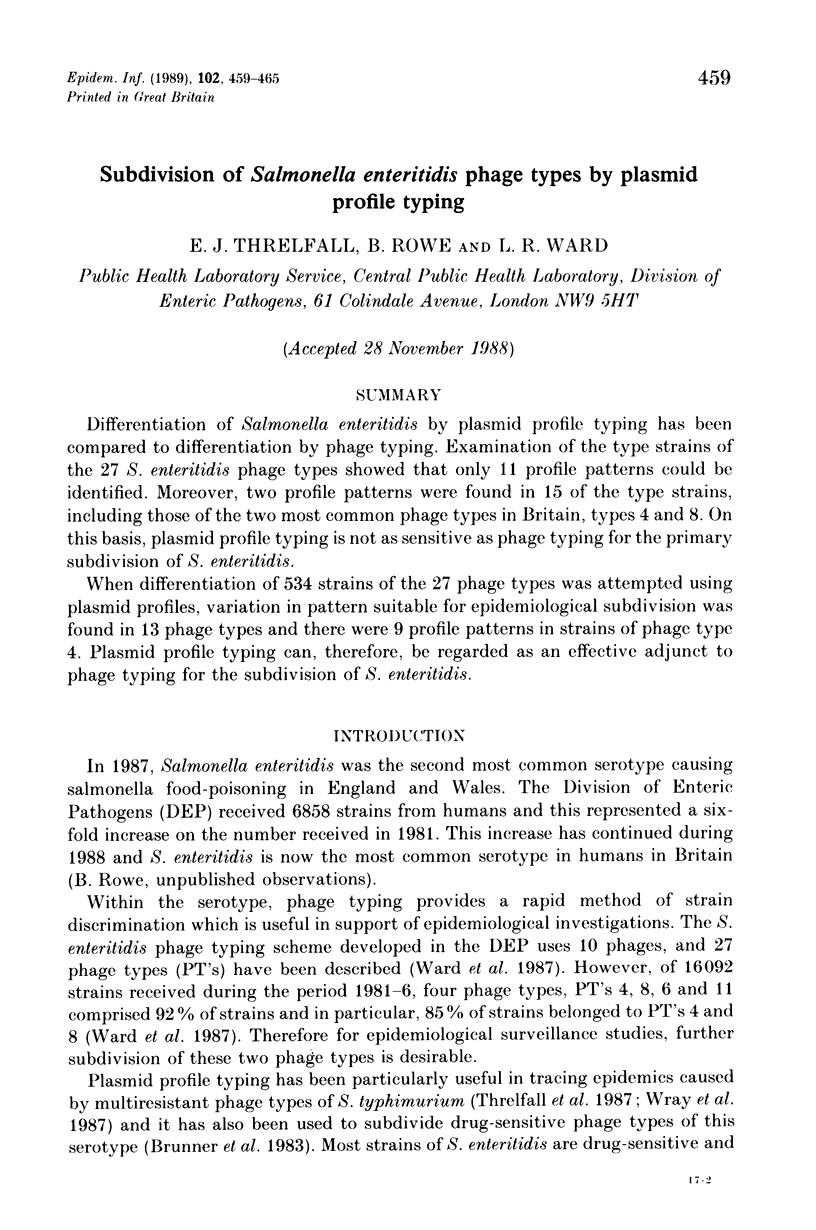Abstract
Differentiation of Salmonella enteritidis by plasmid profile typing has been compared to differentiation by phage typing. Examination of the type strains of the 27 S. enteritidis phage types showed that only 11 profile patterns could be identified. Moreover, two profile patterns were found in 15 of the type strains, including those of the two most common phage types in Britain, types 4 and 8. On this basis, plasmid profile typing is not as sensitive as phage typing for the primary subdivision of S. enteritidis. When differentiation of 534 strains of the 27 phage types was attempted using plasmid profiles, variation in pattern suitable for epidemiological subdivision was found in 13 phage types and there were 9 profile patterns in strains of phage type 4. Plasmid profile typing can, therefore, be regarded as an effective adjunct to phage typing for the subdivision of S. enteritidis.
Full text
PDF






Selected References
These references are in PubMed. This may not be the complete list of references from this article.
- Brunner F., Margadant A., Peduzzi R., Piffaretti J. C. The plasmid pattern as an epidemiologic tool for Salmonella typhimurium epidemics: comparison with the lysotype. J Infect Dis. 1983 Jul;148(1):7–11. doi: 10.1093/infdis/148.1.7. [DOI] [PubMed] [Google Scholar]
- Holmberg S. D., Wachsmuth I. K., Hickman-Brenner F. W., Cohen M. L. Comparison of plasmid profile analysis, phage typing, and antimicrobial susceptibility testing in characterizing Salmonella typhimurium isolates from outbreaks. J Clin Microbiol. 1984 Feb;19(2):100–104. doi: 10.1128/jcm.19.2.100-104.1984. [DOI] [PMC free article] [PubMed] [Google Scholar]
- Kado C. I., Liu S. T. Rapid procedure for detection and isolation of large and small plasmids. J Bacteriol. 1981 Mar;145(3):1365–1373. doi: 10.1128/jb.145.3.1365-1373.1981. [DOI] [PMC free article] [PubMed] [Google Scholar]
- Macrina F. L., Kopecko D. J., Jones K. R., Ayers D. J., McCowen S. M. A multiple plasmid-containing Escherichia coli strain: convenient source of size reference plasmid molecules. Plasmid. 1978 Jun;1(3):417–420. doi: 10.1016/0147-619x(78)90056-2. [DOI] [PubMed] [Google Scholar]
- Threlfall E. J., Hall M. L., Rowe B. Salmonella gold-coast from outbreaks of food-poisoning in the British Isles can be differentiated by plasmid profiles. J Hyg (Lond) 1986 Aug;97(1):115–122. doi: 10.1017/s0022172400064408. [DOI] [PMC free article] [PubMed] [Google Scholar]
- Threlfall E. J., Rowe B., Ferguson J. L., Ward L. R. Characterization of plasmids conferring resistance to gentamicin and apramycin in strains of Salmonella typhimurium phage type 204c isolated in Britain. J Hyg (Lond) 1986 Dec;97(3):419–426. doi: 10.1017/s0022172400063609. [DOI] [PMC free article] [PubMed] [Google Scholar]
- Threlfall E. J., Rowe B., Ward L. R. Increase in prevalence of a neomycin/kanamycin-sensitive variant of S typhimurium DT204c in cattle in Britain. Vet Rec. 1987 Apr 11;120(15):366–367. doi: 10.1136/vr.120.15.366. [DOI] [PubMed] [Google Scholar]
- Ward L. R., de Sa J. D., Rowe B. A phage-typing scheme for Salmonella enteritidis. Epidemiol Infect. 1987 Oct;99(2):291–294. doi: 10.1017/s0950268800067765. [DOI] [PMC free article] [PubMed] [Google Scholar]
- Wray C., McLaren I., Parkinson N. M., Beedell Y. Differentiation of Salmonella typhimurium DT204c by plasmid profile and biotyping. Vet Rec. 1987 Nov 28;121(22):514–516. doi: 10.1136/vr.121.22.514. [DOI] [PubMed] [Google Scholar]


